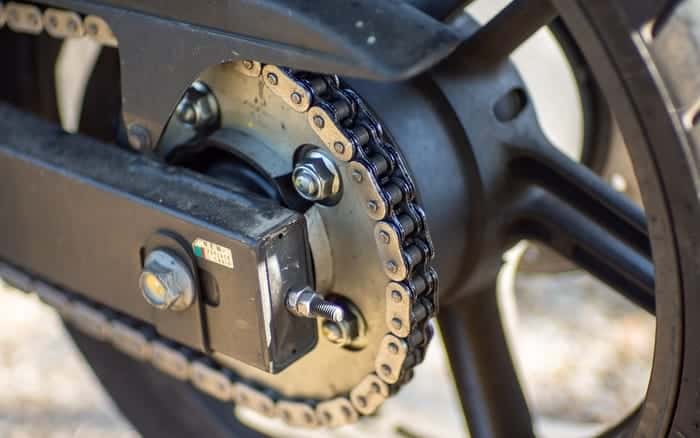
Because motorcycles are much smaller than cars and have less components, every part of a motorcycle serves an important and vital part of it’s function. The chain on a motorcycle is especially vital in making the motorcycle go in the first place.
That’s why chain maintenance and ensuring the tension is correct is so important. It happens too often where people tighten their motorcycle chain too much and end up in a less desirable situation that could have easily been prevented.
What happens if a motorcycle chain is too tight? When a motorcycle chain is too tight, it’ll put stress on several components and cause the sprockets to wear faster, make the engine work harder, and cause the suspension to be tight and uncomfortable during a ride. Ultimately, a tight chain on a motorcycle may break leaving you with no power.
The chain tension on a motorcycle is never something you should neglect. The tension should be promptly adjusted if you suspect the chain is too tight on your bike. This article will explain what happens to a motorcycle when it’s too tight and what to do if you find yourself in this situation.
What Happens When A Motorcycle Chain Is Too Tight?
A drive chain serves a vital purpose on a motorcycle. The engine is what creates the automated power it needs which is then delivered through the chain to the back tire. This makes it possible for the motorcycle to go. Without the chain, the motorcycle would remain stationary.
Chain maintenance is basic knowledge among motorcyclists and is usually a simple task to perform. But because every motorcycle is different with specific specs pertaining to the drive train, some motorcyclists mistake how tight the chain needs to be on their bike and may tighten it too much.

When a motorcycle chain is tight, several things may occur. First, a tight chain will cause the sprockets to wear out much more quickly. The tightness of the chain will put more stress on them than usual which leads to the teeth getting worn down and possibly bending or warping the sprockets altogether.
The engine will have to work harder to make up for the tightness of the chain. The chain has an indirect connection to the engine through the front sprocket. That front sprocket is going to have to work harder to rotate the chain which ultimately means the engine is forced to work harder in those conditions.
An engine working harder also means worse gas mileage. Any time there is a force working against the engine, the engine will require more energy and fuel to make up the difference.
In addition, a tight motorcycle chain will also have an impact on the rear suspension of the motorcycle. The rear sprocket is usually connected to the rear suspension of the motorcycle through a series of other parts. With a chain being too tight, that causes tightness and stress on the rear suspension. This can be quite uncomfortable for the rider.

The chain itself will also become worn out much more quickly. The stress between each link may become too much and, in extreme cases, may break while you’re out for a ride.
A chain breaking while the motorcycle is in motion is extremely dangerous. It’s possible for the chain to jam up one of the sprockets causing the rider to come to an abrupt stop, it could fling backwards and hit another vehicle, or it could snap up towards a rider’s leg and cause an injury. See my other article here to learn more about what happens when a motorcycle chain breaks.
Symptoms Of A Chain That’s Too Tight
Sometimes it can be hard to tell if your chain is at the right tension, especially if you find yourself in a situation where you don’t have the correct tools to check it. There are a few symptoms to look out for that can indicate you have too tight of a chain.

First, you may notice that your gas mileage isn’t as good as it used to be. It’s always good practice to write down in a little notebook what your gas mileage is every time you fill up. This can help identify underlying problems. However, bad gas mileage isn’t caused by a tight chain alone, so look for other accompanying signs that may indicate this issue.
You may have noticed a “whirring” or high pitched sound coming from your motorcycle while you’re riding it. It’s likely that it gets worse the faster you go. This is a tell-tale sign of a motorcycle chain that’s too tight.
As we had discussed, a tight chain also impacts the rear suspension of the bike. This is something you’ll likely feel, especially when you go over any bumps while on a ride. Anything other than smooth road will be uncomfortable for you since the suspension isn’t able to absorb the shock.
Also inspect the rear sprocket and it’s condition. The teeth on it should be pointed and they all should look the same. A strained chain will quickly wear down the teeth which could later make the chain slip off altogether.
The best way to detect whether or not the chain is too tight is to check the tension manually. A seasoned motorcyclist will be able to tell if it’s too tight by simply moving the chain up and down while the motorcycle is off and on it’s center stand. Using a tape measure will be able to tell you exactly how tight or loose it is and give you the answer you need.
How Tight Should A Chain Be?

There isn’t one magic answer that fits all motorcycles when it comes to knowing exactly what the chain tension should be. Because each motorcycle is different, they’re each going to require a different measurement of tension.
On average, however, most street motorcycles will need a chain tension of about 20 – 30 mm, or about a half inch to an inch in slack. This means that the chain should be able to move about a half inch to an inch up and about a half inch to an inch down.
It’s easiest to measure this using a measuring tape. While the motorcycle is off, put the motorcycle on it’s center stand and locate a spot on the lower half of the chain in between the two sprockets. Place the end of the tape measure at the bottom of the swing arm and use the link pin as your point of reference. The link pin should move up and down to the specified measurements. If it doesn’t move that much, your chain is too tight.
Check your owner’s manual to know how much chain slack your specific motorcycle requires. Some motorcycles require a much tighter chain while others require ones that are more loose.
What Would Cause A Tight Chain?
There are many motorcyclists who are left wondering how their chain became tight over time without actually adjusting it themselves. This does happen and there are a few reasons as to why.
First, sometimes when you buy a motorcycle either from a private seller or a dealership, the previous owner adjusted the chain wrong. Make sure to check the chain tension before taking it for a ride any time you buy a new motorcycle.
Check the chain tension on several spots of the chain to get an accurate reading of what the real tension is. Some chains will have a “tight spot” which can give an inaccurate result and lead the owner to believe the chain is too tight.
The likely culprit, however, is that the rear wheel has somehow become too loose and is automatically adjusting the chain too tight. Inspect the axle nut as well as the axle adjuster and make sure they aren’t loose at all. Sitting on a motorcycle with with these loose nuts will push the tire back and cause the chain to become too tight.
Related Question
Why does a motorcycle chain rust? A rusting motorcycle chain is usually caused by a lack of maintenance including regularly cleaning and lubricating the chain as well as riding the motorcycle in rough conditions such as wet, salted roads. See my other article here for more information.

